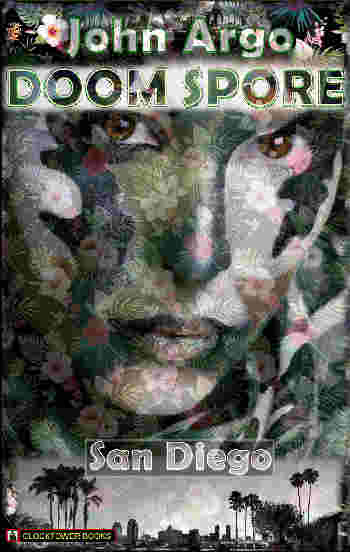8.
 Nearly 11,000 miles away from Tokyo, on the eastern slopes of the Andes Mountains in Peru, looking toward the Amazon Basin rather than the Pacific Ocean, a different smoky scenario played out its timeless beauties and terrors. As the Andes sloped downward and eastward from high, dry, freezing cold above a mile high toward the jungles of the continent's center, an ancient fold lay open in the cliffs hundreds of feet above the tree line. This thin fissure that dropped straight down was dark inside with jungle growth, widening in a steep drop to a yawning volcanic caldera in the high jungle. The volcano had been extinct for eons, and the blasted remains of its crater were thickly overgrown with lush growth. The crater contained a lake a quarter mile across, which glittered dark blue in the filtered light coming down through the fissure. In the middle of the lake lay an island the size of several aircraft carriers, formed by cooled lava left from the volcano's last eruption. This plug, rising several hundred feet above the steaming lake surface, was covered with green forest growth that should harbor a great variety of living organisms, but looked strangely quiet, motionless, and devoid of bird life. Nearly 11,000 miles away from Tokyo, on the eastern slopes of the Andes Mountains in Peru, looking toward the Amazon Basin rather than the Pacific Ocean, a different smoky scenario played out its timeless beauties and terrors. As the Andes sloped downward and eastward from high, dry, freezing cold above a mile high toward the jungles of the continent's center, an ancient fold lay open in the cliffs hundreds of feet above the tree line. This thin fissure that dropped straight down was dark inside with jungle growth, widening in a steep drop to a yawning volcanic caldera in the high jungle. The volcano had been extinct for eons, and the blasted remains of its crater were thickly overgrown with lush growth. The crater contained a lake a quarter mile across, which glittered dark blue in the filtered light coming down through the fissure. In the middle of the lake lay an island the size of several aircraft carriers, formed by cooled lava left from the volcano's last eruption. This plug, rising several hundred feet above the steaming lake surface, was covered with green forest growth that should harbor a great variety of living organisms, but looked strangely quiet, motionless, and devoid of bird life.
The Comet followed the minutely detailed maps held by her navigator. They located the natural fissure in the Cordillera Orientale slope near the beginning of the vast Manu River rain forest area. Spiraling down to half a mile altitude, the float plane entered the magical-seeming environment of the fissure. Below, as the two men looked out speechlessly, was a circular lake, colored dark blue. In its middle rose a 300 foot high island covered in green tree crowns that masked what looked like rocks and buildings. As they descended, a mile-high granite rock face with two curving, sheltering arms was on their west, while on their east the endless jungle opened up. On the east, there was endless blue sky in a swollen humid haze over the topmost canopy. The plane kept circling lower. They saw a few wheeling gulls and hawks, and even two condors circling high up, but lower down there was a noticeable void of bird life. As they circled lower and lower, they gaped at what looked like an abandoned city on the island in the middle of the caldera. The architecture was oddly sinuous, superimposed upon the more massive, squat stonework typical of most South and Central American civilizations. The two men caught only glimpses of the buildings buried in leafy tree crowns. Soon, the aircraft set down on the glassy, opaque surface near the island's shore. The water had a stony quality, like green jade. Bits of fog drifted over the surface amid a brooding stillness. The two men slid back the plane's canopy and threw out a large package—their life craft, which hit the water and inflated in staged popping noises. The two men clambered out, coughing in the noxious air. They carried backpacks containing hatchets, flashlights, and anything else they might need during a stay of several hours. They knew that their I-400 class submarine was by now submerged and hiding from U.S. and other Allied planes, for the boat was a juicy target, and its mission was too important for it to be lost to some random accident. The two pilots in the caldera about 500 miles away were well aware of the sub's vulnerability, and worked with a sense of urgency to get their mission over with.
The air was thick and sulfuric, almost unbreathable. Coughing and wheezing, they rowed the raft toward a slimy little shore under a dark overhang of thick forest leaves. They climbed out and made their way through thickets of thorns toward the beckoning cities that had been abandoned centuries earlier. Not even the Inca had ventured into this place, though most likely they had known of it. The city had the characteristic pyramids and monolithic statues of the region. It also had great, multi-colored growths that hung like sconces and pediments on the buildings. Here and there, a huge round sphere opened its mouth and exhaled a black trail of swirling spores. Too late, the men realized they had stepped into a place whose treasures would not easily be given up. The inhaled the earthy, metallic, odd scent of the place. Their lungs filled with a dull mushroomy taint that slowed their stop and made their hearts labor in their chests. They staggered about the streets of the lost city in awe, forgetting their mission, as a different set of realities took over. Here was a city sculpted in fungi. Its creators had long disappeared, having died in a lost war with an insidious enemy. Now it was the turn of these two Japanese pilots to succumb to the powers of this place. The two men sank to their knees, then slowly collapsed face-down. Even then, green and white molds began to cover them as if they were slowly drowning in decay.
After a long silence, the two pilots returned to their rubber raft. Each, visible only as a dark silhouette in the deep shade under so much jungle growth, carried two large, round objects—one under each arm. As they emerged from the shade, they looked perfectly normal and calm as if nothing had happened. Placing their burdens in the dinghy, they pushed off and started paddling to their quietly waiting sea plane.
Suddenly, from the outer shores of the caldera, where vines and leafy tree branches hung over the edges of the volcanic crater, arrows hissed over the water. Arrows cut through the drifting fog and crossed over waters bubbling with subterranean gases that killed birds dead if they even flew near the water's surface. The two Japanese pilots, even in bulky flight suits, were pierced by multiple arrows and slid into the water. Their bodies sank below the surface. The rubber raft drifted toward the float plane but gradually deflated and sank bubbling under the surface.
Copper-skinned Guardians stippled with white and red dots stood watching as their handiwork found its proper result.
Frantic radio exchanges between I-400 and her network flew back and forth with Tokyo. Lingering through the night, as Allied sub hunter planes flew out on routine patrols, the disappointed monster finally sank beneath the waves and cruised back toward the homeland.
The float plane in the jungle remained sitting on the waters for many years, until finally its pontoons rusted through in the extreme warmth and moisture. The plane tipped nose forward into the water and disappeared beneath the surface. A trail of oily, rusty bubbles boiled up through the alkaline waters, and then all returned to normal. By then, men had walked on the Moon and other great events had come and gone. The new Millennium came amid a welter of violence in New York City and elsewhere. New fanatics appeared and human history rolled on. Wars came and went, their reasons forgotten as soon as the last body bags rolled off the evac planes. But there was one more chapter to be written on Unit 731—to be added to Major Tomio Karasawa's memoirs—carried thousands of miles through Burma and China, and eventually to show up in San Diego, California.



|
  Thank you for reading. If you love it, tell your friends. Please post a favorable review at Amazon, Good Reads, and other online resources. If you want to thank the author, you may also buy a copy for the low price of a cup of coffee. It's called Read-a-Latte: similar (or lower) price as a latte at your favorite coffeeshop, but the book lasts forever while the beverage is quickly gone. Thank you (JTC). Thank you for reading. If you love it, tell your friends. Please post a favorable review at Amazon, Good Reads, and other online resources. If you want to thank the author, you may also buy a copy for the low price of a cup of coffee. It's called Read-a-Latte: similar (or lower) price as a latte at your favorite coffeeshop, but the book lasts forever while the beverage is quickly gone. Thank you (JTC).
|
TOP
|
MAIN
Copyright © 2014 by Jean-Thomas Cullen, Clocktower Books. All Rights Reserved.
|